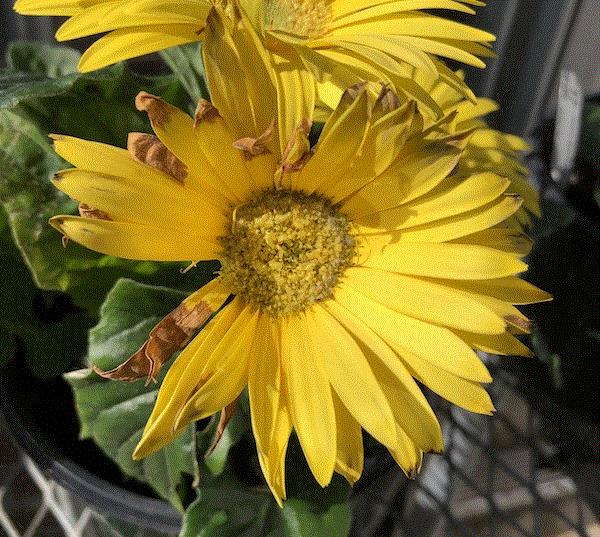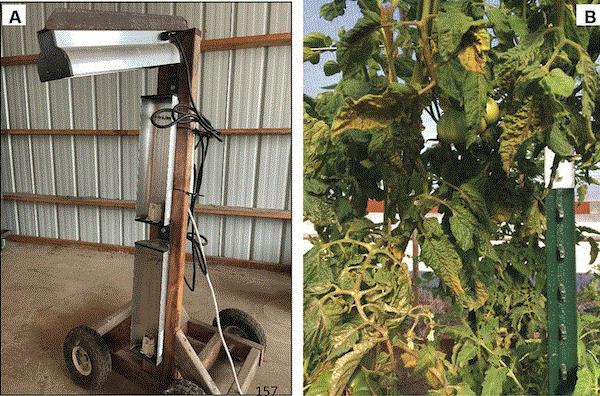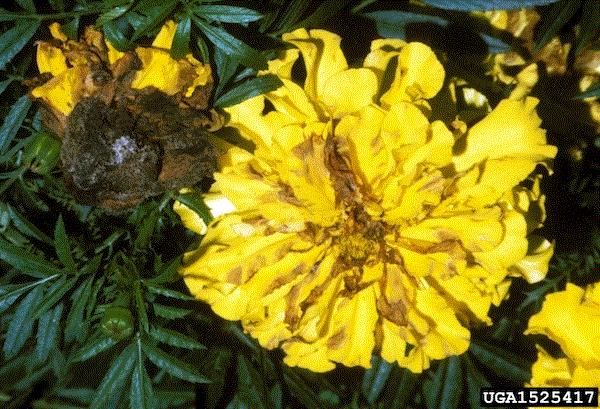What the ... ?
I took this picture of a gerbera daisy (Jaguar Yellow) in my research greenhouse about a month ago. There are about 40 or so plants on the same bench and this was the only one that had necrosis on the flower petals. No damage on leaves or flowers that appeared after this one.
What’s wrong with it?

UV Light Reduces Powdery Mildew
A research paper was published in HortTechnology (Volume 33, Issue 2) by Kristine Buckland and her colleagues at Oregon State University. The team investigated the potential of using ultraviolet (UV) light to control powdery mildew (Leveillula taurica and Oidium neolycopersici) of tomato plants grown in high tunnels.
The team built a mobile stand (see below) to shine UV-C light (at the wavelength of 253.7 nm.) on tomato plants (Cherokee Purple). Each tomato plant received 60 or 90 seconds of UV-C light twice a week. The incidence and severity of powdery mildew on these plants was recorded and compared to disease severity on untreated tomato plants or tomato plants treated with Milstop (potassium bicarbonate) weekly at 4.25 lb. a.i. per acre.

A) Hand-constructed stand cart (5-ft. tall) used for ultraviolet-C (UV-C) treatments. The cart contains three UV lights (2 ft. x 5 ft.; CleanLight XL) that produces broadband UV-C at 253.7 nm. The cart was placed next to and above individual tomato plants for treatment. B) Phytotoxicity on a tomato plant after receiving the first two treatments of UV-C light for 90 seconds per plant. (Photo credit: Buckland et al. 2023; HortTechnology 33, 2.)
Results (drum roll, please) show that UV-C treatment in the summer (June and July) completely eliminated powdery mildew and reduced powdery mildew incidence and severity by more than half (when compared to the untreated and Milstop) in the fall (October and November).
A negative consequence was the tomato plants irradiated with UV-C light in the summer were shorter and produced fewer fruits. Long irradiation time (90 seconds) also caused significant phytotoxicity on tomato plants. This study showed that UV-C has potential for powdery mildew management. The next step is to figure out what to do about the reduction in plant height and fruit production.
This study makes me wonder if the same technology can be used for the management of powdery mildew and other diseases on ornamental plants. A quick literature search found a study by Kobayashi and colleagues (2014; Environmental Control in Biology 51: 157-163), which reported that six hours of UV-B (265 to 385 nm.) irradiation completely suppressed powdery mildew (Podosphaera pannosa) on roses. However, results from other fungal diseases and plants (such as strawberry and rice) suggest that the power of UV light to suppress diseases may not be consisten. All this leads to a favorite conclusion of scientists—additional studies are needed.
Click HERE for a review paper on the efficacy of UV-B on disease suppression.

Answer to "What the ... ?"
You think it was Botrytis (gray mold) infection on the gerbera daisy flower? Unfortunately, no. That was my first guess, too. I cut a piece of the necrotic petal and put it in a Petri dish with moist filter paper to induce sporulation. I did that to confirm my suspicion and to induce a mess of spores to take a nice picture for this newsletter. But no spores after a week! That means it’s something else.
That daisy was the only one on a bench of about 40 plants that showed the necrotic symptom. I asked my technician, Jimmy, what had been done to the daisy recently. It turns out that the daisies were treated with a soil drench of dinotefuran a few days before the symptom showed up. The necrosis on the flower petals may be the symptom of phytotoxicity.
Now, let me finish my story before y’all go out there and start telling your applicators not to use dinotefuran anymore. In my many years of testing dinotefuran and interacting with folks who use dinotefuran, I haven’t heard of any serious phytotoxicity issues associated with dinotefuran.
I think this is a case of over-dosing. Jimmy couldn’t quite remember what was done, but I suspect that, based on the fact that the symptomatic plant was on the edge of the bench, it might have been a recipient of all the surplus solution at the end of the treatment. This over-dosing caused a very high amount of the systemic insecticide to concentrate at the end of the flower petals, damaged the flower tissues and caused the necrosis.
Too much of a great thing can cause problems, especially when not used or applied according to label instructions. This is the same for a generally crop-safe product, such as dinotefuran. Over-dosing is often an easy way to ruin a crop. Take this as another cautionary tale of being very careful when making pesticide applications.
One good thing about phytotoxicity is that, if the growing tissues aren't damaged and the plants aren't killed, the newly expanded tissues usually don’t express the same symptoms. Flowers opened a week after the occurrence of the symptoms were perfect.

Springtime is Botrytis Time
I was going to use the gerbera daisy as a lead-in to talk about Botrytis. Well, not having an example of Botrytis doesn’t really stop me from talking about that.
Spring is here and the heat has returned to South Carolina. The risk of Botrytis is relatively low in my neck of the woods this week because the air is very dry and the fans are running at full speed due to the high temperature. However, the risk is still relatively high in other parts of the country. Spring is typically the time when Botrytis wreaks havoc on spring crops. Relative humidity is high and the air circulation isn’t at its optimal during cool, cloudy days, which are the best time to have Botrytis outbreaks. The risk is particularly high for growers who are holding mature plants in the greenhouses.
Botrytis management requires both cultural and chemical tactics. Management should start with sanitation. Botrytis spores can survive for quite some time on dead tissue on plants, and debris on benches and floors. Cleaning up these dead tissues, unsold plants and debris will help cut down on the amount of spores.
Next, increase airflow and reduce relative humidity by venting or heating. Limiting irrigation to when the plants need it can also reduce the amount of free moisture and relative humidity.

Botrytis on marigold. (Photo credit: Ron Jones, North Carolina State University; bugwood.org.)
Preventive fungicide application will be needed, especially when cloudy or chilly conditions are forecasted to continue for days. It’s important to remember that fungicides work better at preventing an outbreak instead of curing an outbreak. To fully prevent an outbreak, you should choose the most effective fungicides, use high rates and apply regularly. Rotate fungicides among different modes of action or FRAC numbers because Botrytis is notorious for its ability to develop fungicide resistance.
Mary Hausbeck of Michigan State University recommends these fungicides for Botrytis management: azoxystrobin + benzovindiflupyr (Mural; FRAC 11 + 7), chlorothalonil (Daconil; M05), cyprodinil + fludioxonil (Palladium; 9 + 12), fenhexamid (Decree; 17), fludioxonil Medallion WDG/Spirato GHN; 12), fluopyram + trifloxystrobin (Broadform; 7 + 11), fluxapyroxad + pyraclostrobin (Orkestra Intrinsic; 7 + 11), isofetamid (Astun; 7), and polyoxin D zinc salt (Affirm WDG; 19).
Iprodione (Iprodione Pro 2SE/Chipco 26019/26 GT; 2) and pyraclostrobin + boscalid (Pageant Intrinsic; 11 + 7) can also be included in the management plan if the disease pressure is low. Click HERE for Mary’s list of fungicides for managing Botrytis and other diseases.
Click HERE for an e-GRO article on scouting and managing Botrytis in greenhouses.

UConn Offers Training for Spanish-speaking Workers
Rosa Raudales, Carla Caballero and Mayra Toro of the University of Connecticut are offering an eight-part webinar series geared towards training Spanish-speaking workforces in the green industry. Each webinar session will held from 11:20 to 11:50 a.m. during the dates listed below.
Each pre-recorded session is presented in Spanish only and lasts 30 minutes or less. There will be an unrecorded interactive session at the end of each webinar to review the main concepts discussed in the webinar.
Dates and topics of the sessions are (in Spanish):
-
Marzo 20: Saneamiento de superficies duras entre ciclos de cultivos en invernaderos que producen plantas ornamentales
-
Marzo 21: Control de malezas como parte de las prácticas de saneamiento en invernaderos que producen plantas ornamentales
-
Marzo 22: Prácticas de saneamiento durante la temporada de crecimiento
-
Marzo 23: Monitoreo de tarjetas adhesivas amarillas en invernaderos
-
Marzo 24: Pasos de como iniciar un programa de control biológico para plagas de insectos y ácaros
-
Marzo 27: Enfermedad o desorden abiótico?
-
Marzo 28: Como regar cultivos de contenedor
-
Marzo 29: Alimentando plantas
Dates and topics in English:
-
March 20: Sanitation of hard surfaces between crops in greenhouse producing ornamental plants
-
March 21: Weed control as part of sanitation practices in greenhouse producing ornamental plants
-
March 22: Sanitation practices during growing season
-
March 23: Inspecting yellow sticky cards
-
March 24: Steps to get started in biological control
-
March 27: Plant disease or disorder?
-
March 28: How to irrigate containers
-
March 29: Feeding plants
The webinar is free. Click HERE to register.




See y’all later!

JC Chong
Professor of Entomology at Clemson University
This e-mail received by 27,847 subscribers like you!
If you're interested in advertising on PestTalks contact Kim Brown ASAP!